A lot can happen on a CPC.
CPC is short for The College Point Class Conflict Pub Crawl.
And College Point is the isolated and strange little corner of Queens where I grew up. Eight years ago, I jokingly suggested starting a pub crawl through the neighborhood. Not only did the crawl happen, it somehow evolved into an annual social event. ![]()
Dozens have joined us as we walk through the neighborhood, collecting tales of joy and woe, eating phenomenal Sichuan (Chinese) food, and trying not to hurt ourselves. The name has gotten abbreviated from CPCCPC to CPC, and the crawl has happened seven times in the past eight years.
I’m not even sure that I do. But the CPC has helped us pull back the glittery onionskin veneer of the mythologized New York to put one little neighborhood under the microscope — or, at least, at the other end of the camera lens. After nearly a decade of exploring and shooting College Point, the one thing that stands out is change — in people, places, and attitudes.
Before we hit the College Point bars again this year, let’s look back to CPC ’12. That year, the tenor of our conversations with locals changed dramatically. For the first time, there seemed to be new attitudes in and about College Point.
The Voice of College Point Past: Rampaging Vengeful Townie
There, on a quiet corner opposite the Korean deli that still makes the best Italian combo hero in the City, sat The Pourhouse. The since-shuttered bar was a good ten-minute walk from the neighborhood’s main commercial district and all the other bars. In College Point speak, it was down the hill from “Up The Street.”
Everyone in the older group appeared to be wasted, yet having a good time. As I talked with two of my coworkers, a woman from the older crowd approached me. She was a blue-collar woman of about 50, wearing glasses and a zippered sweatshirt.
“Yaw one of the Bellinjah boys,” she said, without any sort of greeting. It sounded like an accusation, and my friends’ ears and faces perked up.
“Yaw the middle one,” the woman said.
“I’m the oldest one,” I replied.
“Yaw the youngest,” she said.
“I’m the oldest.”
“Are you part of this pub crawl?” Clearly she’d heard about the CPC. Internets.
“I started this pub crawl.”
“Yaw grandfatha was crazy!” she said, immediately shifting gears from combative greeting to combat. The expression on my colleagues’ faces changed again as their interest was piqued.
“When I was a little kid,” the woman went on, “Yaw grandfatha slashed my football! I wasn’t even there. My Uncle Paul had to tell me yaw grandfatha found my football in his yard, and he slashed it!”
“I’m surprised he didn’t shoot it,” I responded, not missing a beat. It was true: my rural-Michigan-bred grandfather had enjoyed shooting squirrels out of trees with low-powered rifles, just blocks from this bar. People had called the cops on him for burning leaves, but never for firing a .22 on his back patio. He also grew much of our food in his backyard, 40 years before that was hip.
Cackling periodically, the woman told us what she thought about other members of my family. There was a convoluted story about my mother insulting the woman’s cousin one Halloween —“Yamutha’s crazy! We awl hatuh!” Even though the CPCers were entertained, none could piece the story together afterwards.
Then the Vengeful Townie told me that I didn’t play enough “hockey and baseball” as a child, as if that had stunted my growth. She seriously said this. If you’ve already read A History of the College Point Class Conflict Pub Crawl, you should be nodding right now.
Finally, in the contagious and familiar style of College Point Negativity, the woman wished illness and death on other mutual acquaintances she didn’t like.
“You know her? Oh, she got the flu? Good! I hope she dies!”
This is what passed for everyday conversation when I was growing up. Some things never change.
As we were talked at, a middle-aged man who had been standing slightly off-kilter behind the pool table started moving towards us, sidling up to the Vengeful Townie. When he stopped moving, he was again standing slightly off-balance. If you’ve seen Blue Velvet, he looked a bit like the Yellow Man, after he’s been shot in the head yet continues to stand upright, unconscious, with blood spurting out of the bullethole.
The slanty-standing man in the Pourhouse looked really familiar — was he a former neighbor? A hockey coach? The garbage man? A villain from CPCs past?
“This is my friend, Bill,” said the woman. Where had I met this guy?
“Why, what’s YAWZ?” he asked, as belligerently as possible, with the slurred speech of the truly plastered. “Am I s’posed to know yuh?”
I told him my name, and he told me his. As he mouthed the word — WAWWLSHH — he confirmed my growing suspicion! He was the guy who long-ago antagonized me over my choice of hat on CPC ’08.
I guess he didn’t remember me. Going to the Pourhouse now felt the way I imagined going to a normal high school would have felt, only the bullies were in their 50s and looked like they were in their 70s.
Without bidding us adieu, Bill stumbled away from us and out the door, slowly and carefully navigating the three steps down to the sidewalk. He almost fell, three times.
“I think I met your friend Bill in a place called the Sports Garden,” I said to the Vengeful Townie, who was still standing inches away but finally silent.
“The Spawts Godden?!” she shrieked. “We only go there when it’s a baaad night.” I laughed, but I had no idea what this could mean. The Sports Garden was always the final stop on the CPC, at least when it was in business.
I looked around the room. The younger people had pretty much finished their drinks. It was time for our next bar.
As we exited the Pourhouse, preparing to walk back Up The Street, the Vengeful Townie followed us out. Before we parted, she shouted these exact words from the doorway:
“YAW FRIENDS LIKE YOU! WHY DOANCHA GO ROBBA BANK TAGGETHUH! AHAHAHAHAHA!”
She cackled eerily into the cold night, sounding an awful lot like Large Marge, the ghostly gearjammer in Pee-Wee’s Big Adventure. No one knew what to make of her parting words, so we walked away up College Point Boulevard, leaving the woman and her friends in their self-perpetuating cloud of Olde College Point Misery.
The Voice of College Point Future: City Planner with a Secret
Sometimes the Sports Garden greets Friday night with endless spins of Meat Loaf’s Bat Out of Hell and free shots of orange stuff. Sometimes, the Sports Garden greets Friday night with a rolled-down and padlocked steel gate.
On those nights when the Sports Garden sleeps, our collective heart sinks. We’re then caught in the cold on a sidestreet of unlit houses at 2:30 a.m. And the last open bar in College Point probably closed 90 seconds after its door slammed behind us. Eventually, to avoid the Sports Garden quandary, we began sending an expedition party ahead of the group to see if the tiny single-story bar is open.
In 2012, the expedition party reported good news. The remaining CPC crew walked over to the Sports Garden to get a round.
One of the CPCers wanted to talk to me in private and asked if we could step outside. So we stepped out of the Sports Garden and into its sports garden — like many recreational spaces in Queens, a fenced-in concrete rectangle with a few potted plants.
At first I thought the guy had a Haitian accent, but his name made me think of West Africa. I never asked about his ethnicity; somehow that always seems rude and condescending. Instead we talked about his job as a planner for one of the major City transportation agencies. He handed me his business card, which confirmed that he was a City Planner III. He was the real deal.
“The City has big plans for College Point,” he said. In fact, he said that again and again, but he would never go into any detail, not even when pressed. He quickly changed the conversation back to his own story and why he was in College Point.
After raising his family upstate, the Planner had moved to the City to be closer to his job. He settled in College Point not only because it meant a shorter commute, but because he seemed to have some insider info on the future of the neighborhood.
“My son came back here from college, and he said, ‘Dad, why do you want to live here? It’s a dead city.’ But College Point will rise! We know what we’re doing. If you’re young and you want to invest somewhere, invest in College Point.”
We’d never heard anything like this. We’ve speculated about what could be coming. Manhattan ferry service? Probably not, since College Point was conspicuously excluded from the Citywide Ferry Study. A return to resorts, beach, and boardwalk along the East River, as there was in the 19th Century? No progress there, although kayaks have been spotted in the water off College Point for the first time ever. A 7 Train extension, as first proposed in 1929?
No one knows. But the Planner was genuinely excited about something, and we still want to know why.
The Voices of College Point Present: Faces of Demographic Transition
But Little Pepper — a specialty Chinese restaurant with a growing fan base — could not have existed in the College Point of my childhood. In the words of a friendly barfly we met on CPC ’06, that former College Point was the “last holdout” for white people in the City. Many of those white people adopted racism as a sort of protection against change. But change was inevitable.
And here’s how we met them. Just before CPC ‘12, I published A History of the College Point Class Conflict Pub Crawl, which dealt a lot with the neighborhood’s past hostility to outsiders of all varieties. Immediately, commenters here on The Manic American tried to discredit my experience, saying things to the effect of, ‘Hey! We let the brown kids play baseball and hockey, too!’
People started passing the piece around on College Point Facebook groups, and pretty soon we got a message from Andy Rocco, President of the College Point Civic and Taxpayers Association. Rocco was an atypically young civic leader, at least for College Point. And he wanted to join the crawl.
Few people who grow up in College Point seem to feel any connection to City government. Instead, they consider the local Civic Association — another institution in which they don’t participate — to be the local government. In the ‘80s and ‘90s, my parents would refer to the Civic Association president as the “mayor of College Point,” while talking shit about either Dinkins or Giuliani.
When the Civic Association set up its first website, probably around 2000, it hilariously and desperately tried to portray College Point as a quaint Long Island village, completely disconnected from New York City. Meanwhile, the population exploded with new immigrants, spartan brick cubes rose from the ashes of demolished Victorians, and traffic signals sprung up on every other corner in failed (and failing) attempts to control traffic.
The neighborhood was growing fast. “The diversity of the city was finally exploding in the streets of College Point, and this terrified many longtime residents,” I wrote. People fled in fear. But more people moved in than moved out.
After exchanging texts with Rocco during our Little Pepper meal, we finally caught up with him at A.R.’s Tavern. Rocco was convinced that A.R. himself would give us a CPC special, but A.R. wasn’t working that night. When we shook hands with Rocco, he seemed disappointed that he hadn’t heard of the CPC sooner.
“We could have had you guys picked up in a van at Main Street,” he exclaimed a couple times. He thought the CPC should be even bigger. He wanted to make it a community-wide event.
And he knew a lot of people. For instance, when we told him we didn’t know if the College Point Yacht Club’s bar was still operational, he gave us the Yacht Club President’s personal cell phone number. He also suggested tying more ethnic businesses, like two Colombian restaurants that had recently opened, into future CPCs.
Rocco thought we should meet his friend, Patricia Hoetzel, whom he invited to the bar just to say hello. Hoetzel runs Concepto Media, a trans-ethnic marketing operation. She told us College Point was “now 35% Latino” and that businesses old and new were discovering that they needed to adjust their marketing messages to reach their moving targets.
“No.”
“Are you marketers?”
“No. We just drink and take pictures.”
Hoetzel looked a little confused. But she handed us some business cards before she hit the road.
Next-generation College Point was embracing the neighborhood’s evolution. I already knew what the plastered townies in the Pourhouse would say about this, but they were cowering in the back of their bar, acting irrelevant.
Before he split, Rocco brought up yet another big change in College Point: the former Poppenhusen rubber plant that was recently converted into a hotel.
“Have you made it up to the Hotel de Point?” he asked. “They don’t have their liquor license yet, but their rooftop bar should open soon.” He also suggested checking out the tapas at Cask 15, the upscale bar that had just taken over a shuttered pizzeria’s storefront.
Rooftop bar? The tapas craze? Now, even College Point, the confused industrial neighborhood that once wanted to be a quaint Long Island village, found itself in the outermost ring of New York’s perpetual gentrification cycle.
Often the g-word has a negative connotation. But if College Point’s newfound urbanity means a neighborhood in which different ethnicities coexist, people treat each other as equals, and new types of businesses can thrive, isn’t that a good thing?
The Voice of Reason: The Four Twos Dispatcher
It’s 4:15 a.m., and you’re not going to wait an hour and half for the Q65 to take you back to the subway. You’re definitely not going to walk the two miles of barren “Causeway” to Flushing, which is lined by the menacing silhouettes of asphalt plants and the hulk of the new NYPD academy.
The only thing open is 7-11, and everyone inside is stoned out of their minds. You eat three Taquitos and maybe consume a small Slurpee, and now you feel ill. You call the Four Twos Car Service (718-746-2222) and give the Dispatcher your address:
“You’re at the Sports Garden,” he says in his baritone voice, all-knowing, professorial.
Why, yes, I am. I need two cabs, one to Astoria and one to Brooklyn.
“Alright, who is the Brooklyn cab for?” The Dispatcher always wants the first name of one person going in each cab.
Ten minutes later, he calls back.
“This is Four Twos. Do you see my car outside?”
I do.
“Do you see my other car?”
I do. He never asks if I see his cars, plural.
I join two friends in the car going to Astoria. Once the car door closes I hear the Dispatcher’s voice crackling from the CB radio, which is an antique in the age of GPS and cellphones. The Dispatcher confirms the destination, and thus the fare, with the driver.
“Do you have Rob in your car?” Crackle, crackle.
The middle-aged Asian guy driving asks me my name, and radios his affirmative reply back to the base.
The cab pulls out and races towards the Whitestone Expressway. CPC.
This year’s CPC happens on December 13, 2014. Watch our Facebook and Twitter pages for more information. If you want to read more about the CPC, check out A History of the College Point Class Conflict Pub Crawl.
Written by Rob Bellinger
Photos by Dan Meade and Rob Bellinger
Published November 18, 2014
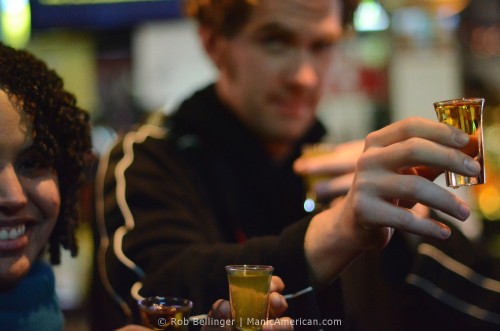
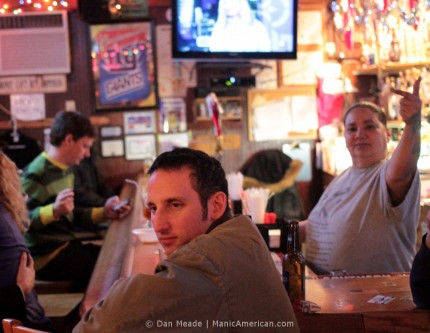
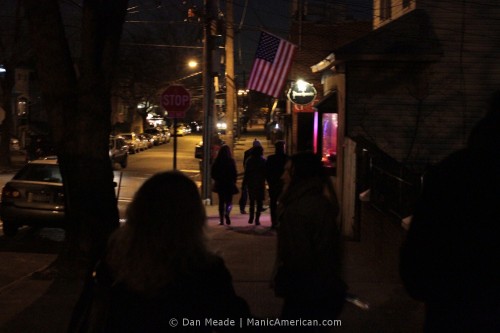
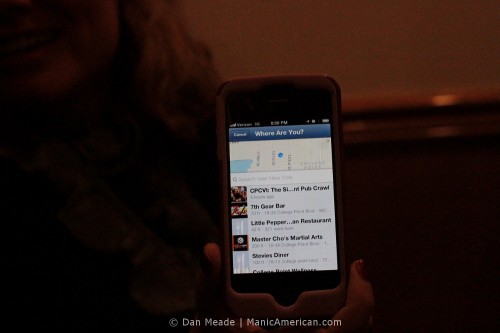
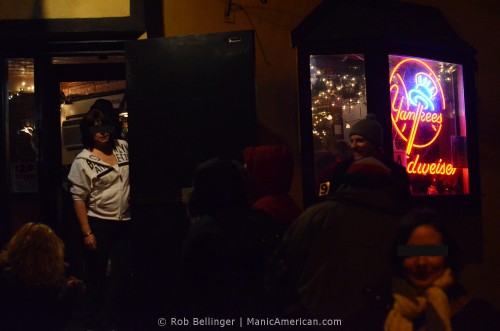
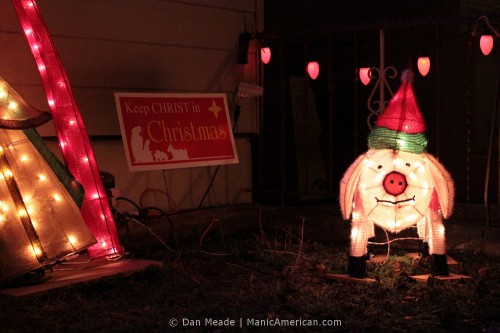
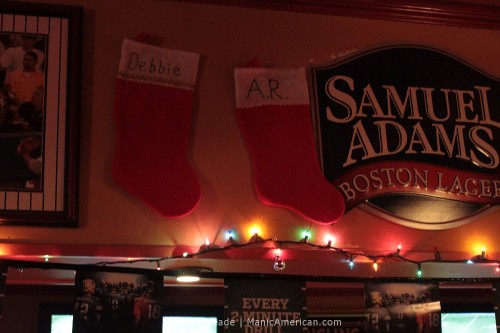
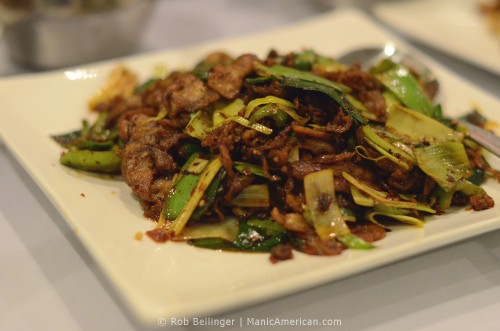
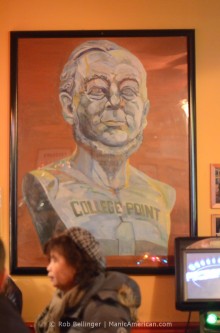
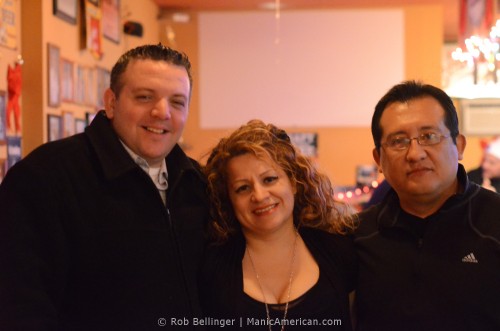
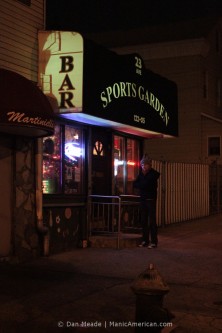
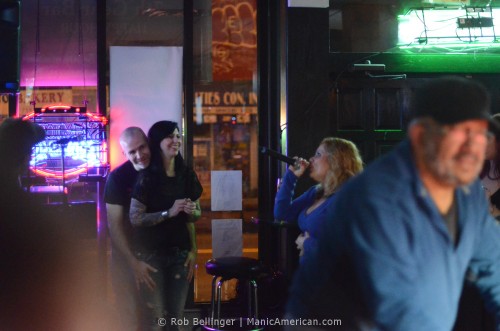
1 Comment
Comments are closed.